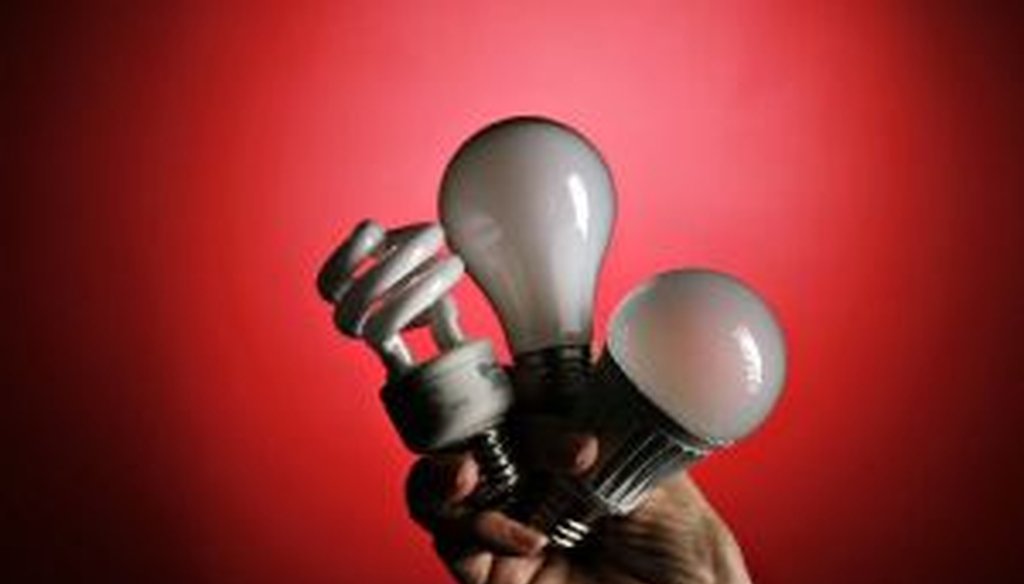Stand up for the facts!
Our only agenda is to publish the truth so you can be an informed participant in democracy.
We need your help.
I would like to contribute

These are three kinds of the most popular light bulbs on the market: compact flourescent light, incandescent and LED.
To illustrate their point that Democrats are expanding government too much, many Republican lawmakers are citing a new law on light bulbs.
The law, which sets standards to make the bulbs more efficient and reduce electricity use, has been derided by Reps. Michele Bachmann, R-Minn., Joe Barton, R-Texas, and Rand Paul, R-Ky., and Sen. Mike Enzi, R-Wyo., as Exhibit A of the liberal assault on the free enterprise system.
A recent fundraising letter making the rounds from a conservative political action committee warns:
"The Democrats have already voted to BAN our conventional lights bulbs (that you and I use even today!) in favor of DANGEROUS fluorescent light bulbs."
The letter comes from AmeriPAC, a political action committee that largely supports conservative Republican candidates, and the Center for the Defense of Free Enterprise Action Fund.
"By outlawing incandescent lights in favor of compact fluorescent lighting, the environmentalists said the country would reduce energy consumption by $18 billion a year, or save consumers between $80 to $180 on their electric bills per year," the letter states. "The plus for the globalists? They said it would reduce global warming because one of the causes of global warming is...you guessed it...the old fashioned Tom Edison light bulb."
The letter seeks contributions and support for S.B. 395, the Better Use of Light Bulbs (BULB) Act, sponsored by Sen. Enzi, which seeks to repeal the light bulb efficiency standards included in the Energy Independence and Security Act of 2007.
"Help put an end to governmental interference in our lives! Help put an end to Mr. Obama interfering with free enterprise!" the letter urges, referring to President Barack Obama.
The letter encapsulates many of the arguments put forth by opponents of the new light bulb efficiency standards, and so we decided to check a number of its claims.
We start with the central claim that, "Democrats have already voted to ban our conventional lights bulbs (that you and I use even today!) in favor of dangerous fluorescent light bulbs."
First off, it's not accurate to pin the law entirely to Democrats. It's true that more Democrats than Republicans voted for the Energy Independence and Security Act of 2007. But it got a measure of bipartisan support and it was signed by Republican President George W. Bush.
More importantly, we found the law does not ban incandescent light bulbs. The law is technology neutral; it requires new light bulbs meet new efficiency standards. It's true that the traditional versions of incandescent light bulbs do not meet those new standards and will be phased out of existence. Compact fluorescent and LED bulbs offer more efficient alternatives, but if incandescent light is your thing, the major light bulb makers have you covered. They are now selling halogen incandescent bulbs that meet the new efficiency standards. We ruled this claim Pants on Fire.
Next, we set the record straight on one of the letter's worst inaccuracies, that "You will be mandated by federal law to get rid of your existing light bulbs."
There is nothing in the Energy Independence and Security Act of 2007 that requires you to get rid of the light bulbs you've got. Rather, the bill sets standards for new light bulbs "manufactured or imported" to the United States.
According to a spokeswoman for the Department of Energy, not only can people keep using their existing bulbs, stores can continue to sell the old ones -- even after the new standards are in place -- until they are sold out.
Or, as Steven Nadel, executive director of the American Council for an Energy-Efficient Economy, put it, "There are no energy police coming to your home to make you remove your light bulbs."
The claim that you have to get rid of your bulbs also got our lowest rating, Pants on Fire.
Next, we addressed the groups' claim that the law will force consumers to buy light bulbs that are significantly more expensive than conventional light bulbs sold today.
"Democrats in Congress passed legislation that raises the cost of a single light bulb to $50!" the letter claims.
That is in reference to a May 16, 2011, AP story about two leading light bulb makers showcasing LED bulbs that are bright enough to replace the 100 watt light bulbs that will be phased out in January -- and which were projected to cost about $50 each.
Later, the letter claims that "the new light bulbs will cost roughly six times the cost of the light bulbs we now use."
That comes from a US News and World Report story which states, "Each cone-shaped spiral CFL [compact fluorescent light] costs about $3, compared with 50 cents for a standard bulb."
There are, however, two major problems with the claims. First, there are two costs to a light bulb: the front-end cost of a light bulb at the store and the cost of electricity to operate it. The letter fails to consider the savings to consumers in the form of lower electricity bills, which the Department of Energy estimates will far outweigh the additional up-front cost of the alternative light bulb options. For details on some of the cost analysis, see our full analysis.
The other problem is the assumption that consumers will have no options come January when the new efficiency standards kick in. Even if you consider only the up-front cost of light bulbs, consumers would not be obligated to buy LED bulbs that cost as much as $50 apiece; nor would they be forced to purchase fluorescent alternatives that go for $3 apiece. There also are halogen incandescent bulbs for $1.49. It's true that all of these options will cost more at the store than traditional incandescent bulbs cost today. But when you factor in the cost of electricity needed to power the light bulb, they will end up costing significantly less. We rated the claim Barely True.
Last, we considered the claims that compact fluorescent light bulbs are "toxic" and "not environmentally friendly" because they contain a small amount of mercury.
Compact fluorescent light bulbs do contain a small amount of mercury, which is a toxic substance. But government and environmental officials say the risk they pose is very small, particularly if the light bulbs are disposed of properly and cleaned up properly if one shatters. Moreover, the dire warnings from opponents of the law fail to acknowledge that there is a price to pay for sticking with less efficient traditional incandescent light bulbs. Those bulbs require far more electricity to operate, and, if they are powered by coal-fired power plants, result in even more mercury emitted into the environment. And so we rated the claim Half True.
Our Sources
See individual items.
















































